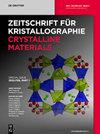Peierls distortion of the cobalt chain in the low-temperature structure of CoIn2
IF 2.7
4区 材料科学
Q3 CRYSTALLOGRAPHY
Zeitschrift Fur Kristallographie-Crystalline Materials
Pub Date : 2022-03-28
DOI:10.1515/zkri-2022-0020
引用次数: 3
Abstract
Abstract CoIn2 (Z. Metallkd. 1970, 61, 342–343) forms by reaction of the elements at 1470 K followed by annealing at 770 K for five days. The room temperature structure is orthorhombic (CuMg2 type, Fddd, a = 529.95(10), b = 940.49(13), c = 1785.8(3) pm, wR2 = 0.0563, 444 F2 values, 17 variables) and shows a phase transition at 195(1) K (DSC data). The low-temperature modification crystallizes in the translationengleiche monoclinic subgroup C2/c and exhibits a new structure type (a = 933.7(7), b = 526.91(10), c = 1000.8(2) pm, β = 117.81(5)°, wR2 = 0.0374, 843 F2 values, 30 variables). The structural phase transition is a consequence of a Peierls type distortion. The equidistant cobalt chains in HT-CoIn2 (270.1 pm, 175.2° Co–Co–Co) show pairwise dislocation in LT-CoIn2 with shorter (252.4 pm) and longer (284.1 pm) Co–Co distances. Each cobalt atom has coordination number 10 in the form of slightly distorted square antiprisms of indium, capped by cobalt on the rectangular faces. Density-of-states calculations reveal metallic behavior for both modifications. Integrated crystal orbital overlap populations featuring the bonding characteristics indicate a slightly higher intensity area for LT-CoIn2 along with a shift to lower energy, manifesting the stabilization by pair formation through Peierls distortion.co_2低温结构中钴链的Peierls畸变
摘要:在1470k下反应,在770 K下退火5天,形成了co_2 (Z. Metallkd. 1970, 61, 342-343)。室温结构为正交型(CuMg2型,Fddd, a = 529.95(10), b = 940.49(13), c = 1785.8(3) pm, wR2 = 0.0563, 444个F2值,17个变量),在195(1)K时显示相变(DSC数据)。低温改性在平动英氏单斜亚群C2/c中结晶,呈现出新的结构类型(a = 933.7(7), b = 526.91(10), c = 1000.8(2) pm, β = 117.81(5)°,wR2 = 0.03774, F2值843,30个变量)。结构相变是佩尔斯型畸变的结果。ht - co_2中的等距钴链(270.1 pm, 175.2°Co-Co - co)在Co-Co距离较短(252.4 pm)和较长(284.1 pm)的ht - co_2中显示成对位错。每个钴原子的配位数为10,呈轻微扭曲的铟反棱镜方形,矩形面上覆盖着钴。态密度计算揭示了这两种改性的金属行为。具有成键特征的集成晶体轨道重叠居群表明,LT-CoIn2的强度区域略高,并向较低的能量转移,表现出通过佩尔斯畸变形成对的稳定性。
本文章由计算机程序翻译,如有差异,请以英文原文为准。
求助全文
约1分钟内获得全文
求助全文
来源期刊

Zeitschrift Fur Kristallographie-Crystalline Materials
CRYSTALLOGRAPHY-
CiteScore
2.00
自引率
16.70%
发文量
55
期刊介绍:
Zeitschrift für Kristallographie – Crystalline Materials was founded in 1877 by Paul von Groth and is today one of the world’s oldest scientific journals. It offers a place for researchers to present results of their theoretical experimental crystallographic studies. The journal presents significant results on structures and on properties of organic/inorganic substances with crystalline character, periodically ordered, modulated or quasicrystalline on static and dynamic phenomena applying the various methods of diffraction, spectroscopy and microscopy.
 求助内容:
求助内容: 应助结果提醒方式:
应助结果提醒方式:


